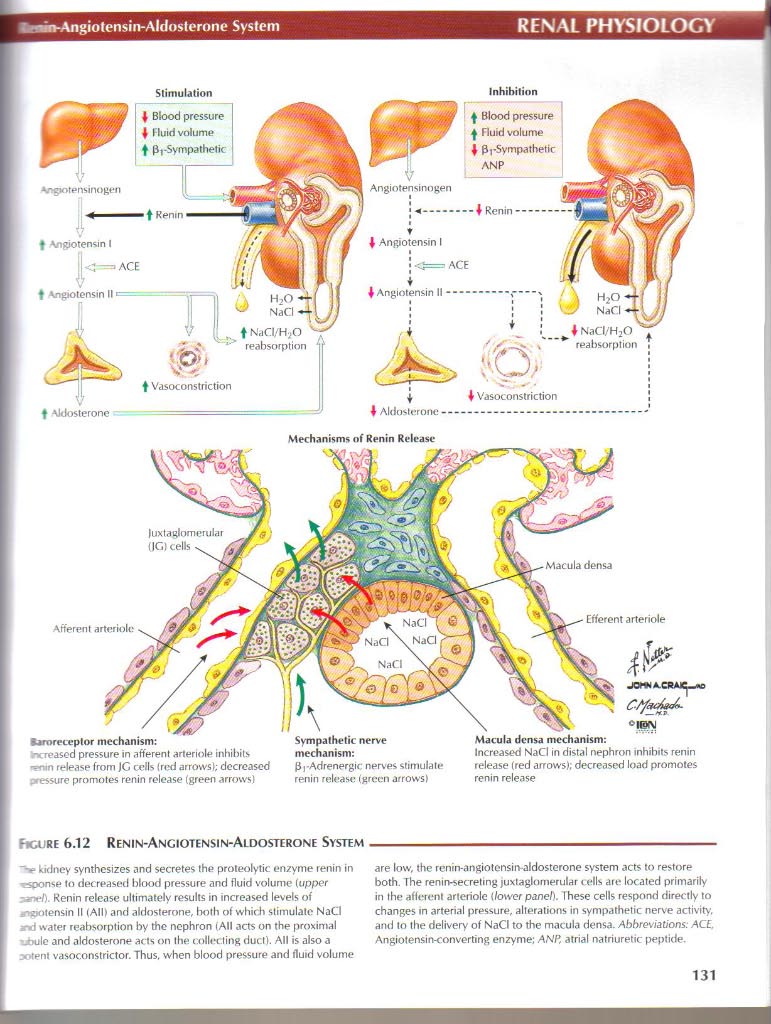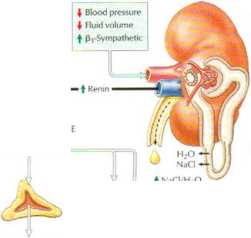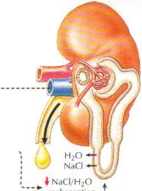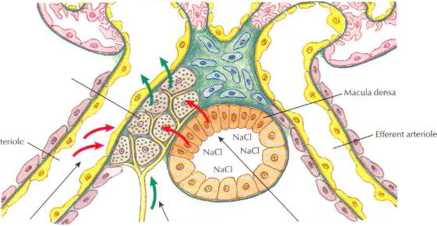netter114

-m-Angiotensin-Aldosterone System
RENAL PHYSFOLOCY
Inhibilion

f Blood pressure f fluid volume | fłj-Sympatbetic ANP
■ ♦ Renin

i ♦ Vasoconstriction
♦ Aldosterone----------------—
Mechanism* of Renin Release

JOeWA-CRA^o
Sympathetic nerve mechanism:
{Ji-Adrenergir nerves stimulale renin releasc (grecn arrowsf
°MM\|
|uxlaglomerular (|G) cells
•arnreceptor mechanism:
nereased pressure in afferent arteriole inhibits ««n release from JG cells (red arrows); dccreased pressure promotes renin release (green arrows)
Macula densa mechanism:
Increased NaCl in distal nephron inhibits renin release (red arrows); decreased load promotes renin release
Figurę 6.12 Renin-Anciotensin-Aldosterone System
"-*> kidney synthesizes and secretes the proteolytic enzyme renin in oporne to decreased blood pressure and fluid volume (upper ^ane/). Renin release ultimately results in increased levels of .-©otensin II (AID and aldosterone, both of which stimulalc NaCl ■d water reabsorption by the nephron i Ali acts on the proximal -hjIc and aldosterone acts on the collec ling duet). Ali is also a :otent vasoconstrictor. Thus. when blood pressure and fluid volume
are Iow, the renin angiotensiivaldosterone system acts to restore both. The renin-seereting juxtagloinerular cells art* located primarily in Ihe afferent arteriole (lower panel). These cells respond directly to changes m arterial pressure, alterations in sympathetic nerve activity, and to the delivery of NaCl to the macula densa. Abbreviations: ACŁ. Angiotensin<onverting enzyme; ANP, atrial natriuretic peptide.
131
Wyszukiwarka
Podobne podstrony:
59840 netter71 CARDIOVASCULAR PHYSIOLOCY Short-Term Regulation of Blood Pressure 2/3t „NE Ganglion-
RENAL PHYSFOLOCY MfrAngiotensin-Aldosterone System SFmulation 4 Blcod pressure
HASŁA I ZAGADNIENIA DO POWTÓRZENIA reninum, angiotensinium, aldosteronium (ang. RAA system) syndroma
netter152 Intrahepatii Biliary SystemGASTROINTESTINAL PHYSIOLOGY Noto. The figurę shows bile canalic
netter36 NEUROPHYSIOLOGY Audilory System: Pathways temporal lobe cortex Medial geniculate body High
netter39 Custatory (Taste) System: Receptors NEUROPHYSIOLOGY A. Tongue B. Section
netter40 NEUROPHYSIOLOGYGustatory (Taste) System: Pathways Sensory cortex łjust below face area) Lat
netter69 CARDIOVASCULAR PHYSIOLOGYCirculation to Special R<-(*ions Brain: blood (Iow normally rem
netter125 fntpric Nervous SystemGASTROINTESTINAL PHYSIOLOGY WW Myenteric plexus (cross section; bema
więcej podobnych podstron